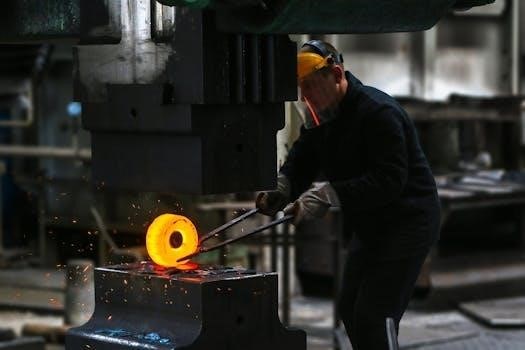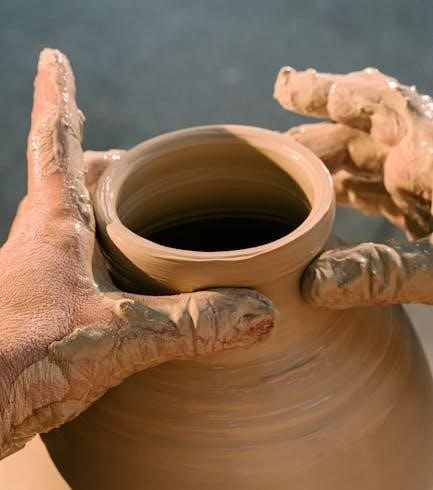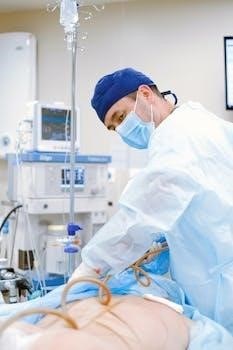Types of Milling Machines
Milling machines are categorized primarily by their control method. They are either manual or CNC. Manual milling machines require direct operator control. CNC milling machines use programmed instructions. This affects precision, speed, and complexity. These two types offer distinct capabilities.
Manual Milling Machines
Manual milling machines involve direct operation, where the machinist controls the machine’s movements using hand cranks and levers. This requires a skilled operator who understands the machining process and can make precise adjustments. Unlike CNC machines, manual milling relies on the operator’s ability to guide the cutting tool along the workpiece, adjust the depth of cut, and control the feed rate. This method is often used for smaller production runs, prototyping, and one-off parts where the flexibility and direct control of the operator are advantageous. The most common configuration is the knee mill, which has a movable table that can be adjusted vertically and horizontally. It is very important to pay attention and always think about safety first.
CNC Milling Machines
CNC milling machines, or Computer Numerical Control machines, operate using a pre-programmed set of instructions. These instructions guide the machine’s movements, controlling the cutting tool along various axes to produce the desired part. This automated process allows for higher precision, greater repeatability, and faster production speeds compared to manual milling. CNC milling is particularly suited for complex designs and mass production of identical parts. The operating system of such machines is a closed loop system and functions on feedback. Programming is typically done using CAM software, which converts a CAD model into the instructions for the CNC machine. It is a prominent method in manufacturing.
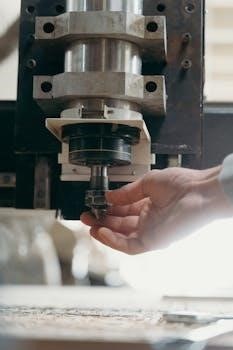
Milling Machine Operations
Milling operations involve various methods for removing material. Common operations include face milling, plain milling, and side milling. These are used to create different shapes, surfaces, and features on a workpiece, using a rotating cutter.
Face Milling
Face milling is a fundamental operation where the cutter’s axis is perpendicular to the surface being machined. This process is primarily used to create flat surfaces on the workpiece. The cutting tool, often a face mill, removes material across the face of the part, resulting in a smooth and even finish; It’s a common initial step in many machining processes to prepare the surface. The depth of cut is carefully controlled to achieve desired dimensions. Face milling can involve both roughing and finishing cuts, with the former removing larger amounts of material quickly and the latter creating a precise finish. This operation is versatile and widely applied in various manufacturing settings, providing a crucial base for further machining operations. The cutter’s movement is typically linear, covering the entire surface area.
Plain Milling
Plain milling, also known as slab milling, involves using a cylindrical cutter with teeth on its periphery to remove material from a workpiece. The cutting tool’s axis is parallel to the surface being machined, making it ideal for creating flat surfaces and slots. This method is efficient for removing large amounts of material quickly. The workpiece is fed along the cutter, removing a layer of material with each pass. Plain milling is used for roughing and creating basic shapes, often followed by other operations for a finer finish. The cutter rotates at high speeds, and the feed rate is adjusted to achieve the desired material removal. It’s essential to secure the workpiece firmly to avoid vibration during the process and maintain accuracy. Plain milling is a common and versatile machining technique.
Side Milling
Side milling is a machining operation where material is removed from the side of a workpiece using a cutter with teeth on its periphery. Unlike face milling, the cutter’s axis is perpendicular to the surface being machined. This process is often used to create vertical edges, grooves, and slots. Side milling is a versatile operation, allowing for the creation of various shapes and contours. The cutting tool engages the material on its side, removing chips as it progresses along the workpiece. Controlling the feed rate and depth of cut is crucial for achieving the desired dimensions and surface finish. Side milling can be performed in a single pass or multiple passes, depending on the amount of material to be removed. It is an essential operation for many machining projects and requires careful setup and precise tool control.

Safety Procedures
Operating milling machines requires strict adherence to safety. This includes using protective gear, inspecting the machine, and knowing emergency protocols. Proper training is also critical for safe operation and avoiding hazards.
Protective Gear
When operating a milling machine, wearing the correct protective gear is absolutely essential for safety. First and foremost, safety glasses or goggles must be worn at all times to shield your eyes from flying chips and debris. These particles can cause serious eye injuries if proper protection is not utilized. Furthermore, it is advisable to wear appropriate work gloves to protect your hands from sharp edges, splinters, or hot metal shavings. However, be sure that they don’t hinder your ability to control the machine. Avoid loose clothing and jewelry that could get caught in the moving parts of the machine; instead, opt for snug-fitting attire. If you have long hair, make sure to secure it in a way that prevents it from getting tangled or pulled by the machine. Depending on the specific job, a face shield might be needed to provide additional face protection. Finally, wearing work boots is essential. Always prioritize your personal safety and make sure that you have all the necessary protective gear. It is essential to take these precautions to prevent injuries while operating a milling machine.
Machine Inspection
Before commencing any milling operation, a thorough inspection of the machine is crucial. Begin by examining the machine’s overall condition. Check for any loose bolts, damaged components, or unusual wear and tear. Ensure that all guards and safety interlocks are in place and functioning correctly. Verify that the spindle is secure and rotates smoothly without any wobble. Inspect the cutting tool for sharpness and proper mounting; dull or improperly mounted cutters can lead to accidents and poor results. Confirm that the work table is clean, clear of obstructions, and moves freely. Check all axis movements, making sure they are smooth and accurate. Lubricate all moving parts as needed. Make sure that the emergency stop button is readily accessible and functional. Furthermore, always double-check all settings and adjustments before starting the milling process. This is to avoid any accidents and ensure the accurate machining of the workpiece. Proper inspection helps maintain efficiency and enhances safety. Taking the time to perform a careful check will contribute to a smooth and safe operation.
Emergency Protocols
In case of an emergency while operating a milling machine, it is vital to have clear protocols in place. The primary action is to immediately activate the emergency stop button, which will halt all machine functions instantly. Operators must know the location of this button and how to use it. If an accident occurs, assess the situation and provide first aid if necessary. If the emergency is more serious, it is important to contact emergency services. Never attempt to restart the machine until the cause of the issue has been identified and addressed. Following an incident, the machine should be thoroughly inspected for damage. Any faulty components should be repaired or replaced before further use. It is essential to document all incidents and near misses, which can be used for training and improvement. All personnel working with the milling machine should be trained in these protocols to ensure a quick and safe response. A comprehensive plan that is well understood by everyone is essential for preventing injury and minimizing damage.
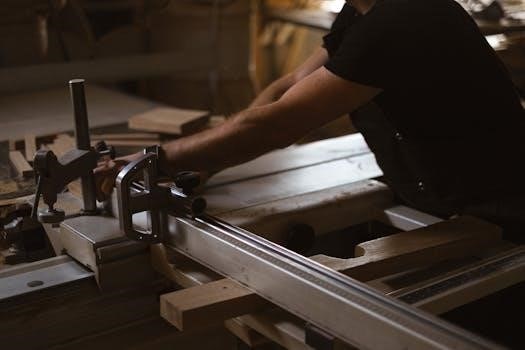
Milling Machine Components
Milling machines have key components. These include the spindle that holds the cutting tool, the table where the workpiece is secured, and the base providing overall support. Understanding these parts is essential for proper operation.
Spindle
The spindle is a critical rotating component in a milling machine. It holds and drives the cutting tool during machining operations. Depending on the machine type, the spindle can be either vertical or horizontal. Vertical spindles are common in knee mills, while horizontal spindles often feature an overarm and arbor support. The spindle’s speed and feed rate are controlled to match the specific machining requirements. The spindle’s design ensures precise and stable cutting. It is crucial for the overall performance of the milling process. Correct setup and maintenance of the spindle are vital for achieving accurate results. The spindle is powered by a motor, and its rotational speed must be adjusted based on the material and cutting tool being used. The spindle is essential for material removal in milling operations. It directly impacts the quality and efficiency of the machining process.
Table
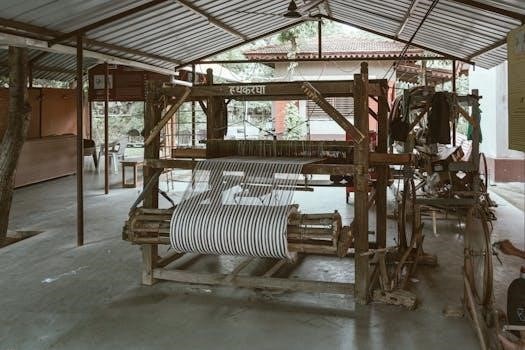
The table is a flat, sturdy platform where the workpiece is securely positioned during milling operations. It is typically made of cast iron, providing stability and reducing vibrations. The table moves along guideways, often located on the knee of the machine, enabling horizontal movement of the workpiece. This movement, along with vertical and cross-slide adjustments, allows precise positioning relative to the cutting tool. Proper securing of the workpiece to the table is essential for safe and accurate machining. The table’s surface must be cleaned and free of obstructions to prevent inaccurate cuts. The table is a fundamental component for controlling the work piece during milling. Different types of work holding devices are attached to the table to securely hold the material. The table’s movements must be smooth and controlled to ensure a quality milling operation.
Base
The base of a milling machine serves as its foundation, providing crucial support and stability for all other components during operation. It is typically constructed from a heavy, rigid material like cast iron to minimize vibrations and ensure accurate machining. The base houses the drive motor, which supplies power to the spindle and other mechanical parts of the machine. It is designed to withstand the forces generated during milling operations, contributing to the overall safety and precision of the machine. The base must be properly secured to the floor or work surface to prevent movement during use. This is a critical structural element that provides a solid foundation for the machine. The base design and material are essential for the machine to perform accurate and safe milling operations.
